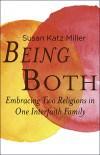
To celebrate the publication last week of Being Both: Embracing Two Religions in One Interfaith Family, this is the second in a series of portraits drawn from my survey of young people who attended dual-faith education programs in NY, DC, Chicago and California. Since the survey was anonymous in order to encourage honest answers, I use pseudonyms here (although the book itself is full of real names). Many of these detailed portraits did not fit into the book, so this is new, bonus material!
The son of a Reform Jewish mother and a Roman Catholic father, Ethan had a combination baptism, bris and baby-naming ceremony as an infant. At age six, his parents enrolled him in the dual-faith religious education program at the Interfaith Families Project of Greater Washington DC. There, he learned Judaism and Christianity in classrooms co-taught by Jewish and Christian teachers, in a program filled with over 100 other interfaith children. At the time he filled out the survey describing his experience, Ethan was 17 years old.
When asked whether he found learning about two religions confusing, Ethan replied, “I always enjoy getting two perspectives of a story before I decide what I believe. This provided a unique opportunity to do just that.” And when asked how his education in two religions has affected his outlook on the world, Ethan wrote, “I feel that I have a broader view of things than most single-faith persons do…I believe that being exposed to multiple faiths allows one to look at the big picture, rather than remain narrow-minded.”
Ethan had a First Communion, and later, became a Bar Mitzvah. At 17, he was attending Church, Synagogue, and Quaker meetings, and said he felt comfortable in both churches and synagogues, but described his religious identity as Quaker. When asked about his belief in God, Ethan wrote, “Being somewhat Quaker, I believe that there is that of G-d in everyone. I speculate as to whether or not there is one supreme being, or if that being is brought to life by fellow humans.”
Overall, Ethan saw being an interfaith child as more of an advantage than a disadvantage. He thinks his parents made a good decision to teach him both religions. And he planned to raise his own future children with an interfaith education. The greatest disadvantage he saw of being an interfaith child was that “It can be difficult to get along at times with conservative or orthodox groups because they don’t believe in multiple faiths.”
Traditionally, clergy and religious institutions have worried that interfaith children raised with two religions would be unable to choose one religion in adulthood, and end up with no religion. But Ethan has found a religious home, at least for now, with the Society of Friends, and will be able to find Quaker meetings in most geographic areas as he heads out into the world.
While he has chosen a primary religious identity as a Quaker, clearly his interfaith education has had a profound effect on Ethan. He writes that the greatest advantage of being an interfaith child is that he believes he has a “broader outlook on life.” And he adds, “People use the term ‘open-minded,’ so I like to think of interfaith as being ‘open-souled’.”

